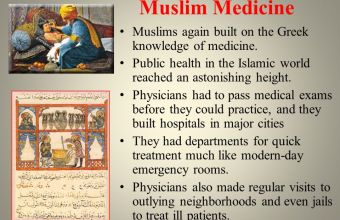Public Health

Public Health
Published: 2002
The earliest hospital in Islam was a mobile dispensary following the Muslim armies, dating from the time of Prophet Mohammed (PBUH), a tradition that remained throughout the centuries of Islamic civilization.
Decades elapsed before the first hospital building was built in Damascus in 706 by Al-Walid, the Ummayad Caliph. It was to cater for all sorts of patients (including the blind and even the lepers). Its equipment, staff, and organization served as a model for other hospitals to follow.
Both Caliphs Harun al-Rashid and Al-Mansur had hospitals built in Baghdad. In Cairo, the first hospital was established at al-Fustat by Ibn Tulun, governor of the city, in 872. By the 12th century, the hospital had become a very advanced institution, witness al-Nuri. A hospital was built in 1156 by Nur al-Din Zangi, where patients were well fed and cared for and a large library for teaching.
Old Public Hospital Egypt
In Cairo, in 1285, Sultan Qalaun al-Mansur built the largest of all hospitals, described Durant,
“Within a spacious quadrangular enclosure, four buildings rose around a courtyard adorned with arcades and cooled with fountains and brooks. There were separate wards for diverse diseases and convalescents; laboratories, a dispensary, out-patient clinics, diet kitchens, baths, a library, a chapel, a lecture hall, and charming accommodations for the insane. Treatment was given gratis to men and women, rich and poor, slave and free, and a sum of money was disbursed to each convalescent on his departure so that he need not at once return to work. The sleepless were provided with soft music, professional story-tellers, and perhaps books of history.”
What is Taught: The Italian Giovanni Morgagni is regarded as the father of pathology because he was the first to describe the disease’s nature correctly.
What Should be Taught: Islam’s surgeons were the first pathologists. They fully realized the nature of the disease and described a variety of diseases in modern detail. Ibn Zuhr correctly described the nature of pleurisy, tuberculosis, and pericarditis.
What is Taught: The concept of quarantine was first developed in 1403. In Venice, a law was passed preventing strangers from entering the city until a certain waiting period had passed. If by then, no sign of illness could be found, they were allowed in.
Ibn Zuhr
What Should be Taught: The concept of quarantine was first introduced in the 7th century A.D. by the prophet Muhammad, who wisely warned against entering or leaving a region suffering from a plague. As early as the 10th century, Muslim physicians innovated isolation wards for individuals suffering from communicable diseases.
What is Taught: The first sound approach to the treatment of disease was made by a German, Johann Weger, in the 1500s.
Ibn al-Razi
What Should be Taught: Harvard’s George Sarton says that modern medicine is entirely an Islamic development and that Setting the Record Straight the Muslim physicians of the 9th through 12th centuries were precise, scientific, rational, and sound in their approach.
Johann Weger was among thousands of European physicians during the 15th through 17th centuries who were taught ar-Razi and Ibn Sina’s medicine. He contributed nothing original.
What is Taught: Medical treatment for the insane was modernized by Philippe Pinel when in 1793, he operated France’s first insane asylum https://indianpharmall.com/.
What Should be Taught: As early as the 1lth century, Islamic hospitals maintained special wards for the insane.
Old public Hospital Aleppo
They treated them kindly and presumed their disease was real at a time when the insane were routinely burned alive in Europe as witches and sorcerers.
A curative approach was taken for mental illness, and, for the first time in history, the mentally ill were treated with supportive care, drugs, and psychotherapy.
Every major Islamic city maintained an insane asylum where patients were treated at no charge. In fact, the Islamic system for the treatment of the insane excels compared to the current model, as it was more humane and highly effective.
God emphasizes in the Qur’an the sacredness of the soul and condemns acts of terror and injustice.
If anyone slays a human being – unless it is [in punishment] for murder or for spreading corruption on earth – it shall be as though he had slain all humanity: whereas, if anyone saves a life, it shall be as though he had saved the lives of all humanity. Quran, 5:32
It is derived from this verse that any act of safety made for saving a human life is therefore considered Islamic.
Thus, Islam promotes safety regulations in traffic, industrial and public places, supports medicinal child-proof-bottling and other accident-preventing measures. This principle of safety applies to the ecological system and promotes a cleaner and healthier environment for all God’s creations.
Recommended Posts

Women’s Rights to Own Property
January 20, 2018

Navigation
January 20, 2018

Algebra
July 4, 2017

